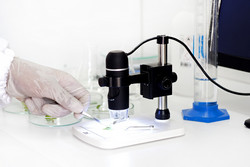Electron microscopy for protein structural analysis
Cryo electron microscopy (cryo-EM) is a transmission electron microscopy technique that provides near-atomic resolution information for large and high-symmetry protein complexes. In contrast to X-ray crystallography, cryo-EM studies these complexes in their physiological environment without the potential artefacts generated during the crystallisation process. However, application of cryo-EM to small proteins is problematic, mainly because of poor signal-to-noise ratios that hamper particle selection and orientation determination. In answer to this, the EU-funded EM-FRAME (DNA-origami scaffolds for structure determination by single particle analysis) project proposed to bind proteins to large 3D scaffolds made of DNA origami. DNA origami is a term used for hollow rectangular frames that contain a DNA double helix on the inside for DNA-binding proteins to adhere. By exploiting the helical character of the DNA, it is possible to rotate the orientation of the bound protein and obtain experimental information on its conformation. To achieve better particle selection, researchers generated new detectors, which provided images with better contrast and greatly facilitated particle selection. They improved the resolution further by developing an image-processing procedure that uses movies from the new detectors to correct for sample motions. The overall performance of the optimised method was validated by solving the near-atomic resolution for the mitochondrial ribosome from yeast and human and the cytoplasmic ribosome from P. falciparum. Routine implementation of the method should help solve the conformation and function of a number of proteins of human origin.







